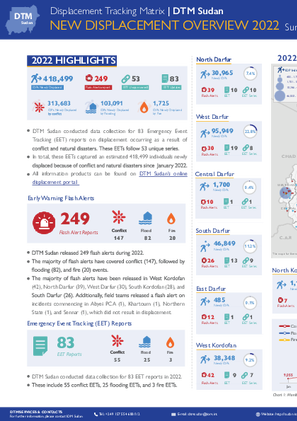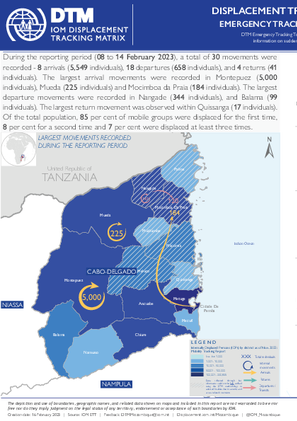-
Countries
-
Data and Analysis
-
Special Focus
-
Crisis Responses
Contact
DTM Burundi, DTMBurundi@iom.int
Location
Burundi
Activity
- Mobility Tracking
- Event Tracking
Period Covered
Feb 12 2023 -Feb 18 2023
Activated on an ad hoc basis, the DTM Emergency Tracking provides early field reports at the beginning of a complex crisis, allowing IOM to gather, consolidate and disseminate baseline information on displacement and return figures at the onset of a newly emerging crisis. The DTM Emergency Tracking relies heavily on information provided by RARTs or partners within the humanitarian community about an unfolding situation. The Emergency Tracking gathers data through IOM Burundi’s extended network of key informants, who provide basic information on the new displacement, be it of IDPs or returnees, or both, including numbers, location and shelter types. While IOM DTM strives to provide best estimates, the Emergency Tracking aims to be a quick monitoring tool with real-time data turnover ranging from 24 to 72 hours following its activation.
Population Groups
Survey Methodology
Unit of Analysis Or Observation
Type of Survey or Assessment
Keywords
Geographical Scope
Administrative boundaries with available data
The current dataset covers the following administrative boundaries
Contact
DTM Somalia Location
Somalia
Activity
- Mobility Tracking
- Event Tracking
Period Covered
Jan 29 2023 -Feb 03 2023
ETT is a crisis-based tool that tracks sudden displacement triggered by specific events or emerging crises. The objective of ETT is to help prioritize humanitarian response and to enable partners to deliver rapid assistance. Based on previous drought induced displacement patterns, and the ones observed since the beginning of the drought, the humanitarian community expects that people will move from rural to urban areas in search of humanitarian services. Consequently, this ETT tool which concentrates only on drought induced displacements, focuses on the main urban centers and surrounding villages for each district. The data is collected through Key Informant Interviews (KIIs) at the location level, from Sunday to Wednesday every week. All locations assessed are monitored each week.
Population Groups
Survey Methodology
Unit of Analysis Or Observation
Type of Survey or Assessment
Keywords
Geographical Scope
Administrative boundaries with available data
The current dataset covers the following administrative boundaries
Contact
DTM Somalia Location
Somalia
Activity
- Mobility Tracking
- Event Tracking
Period Covered
Jan 21 2023 -Jan 27 2023
ETT is a crisis-based tool that tracks sudden displacement triggered by specific events or emerging crises. The objective of ETT is to help prioritize humanitarian response and to enable partners to deliver rapid assistance. Based on previous drought induced displacement patterns, and the ones observed since the beginning of the drought, the humanitarian community expects that people will move from rural to urban areas in search of humanitarian services. Consequently, this ETT tool which concentrates only on drought induced displacements, focuses on the main urban centers and surrounding villages for each district. The data is collected through Key Informant Interviews (KIIs) at the location level, from Sunday to Wednesday every week. All locations assessed are monitored each week.
Population Groups
Survey Methodology
Unit of Analysis Or Observation
Type of Survey or Assessment
Keywords
Geographical Scope
Administrative boundaries with available data
The current dataset covers the following administrative boundaries
Contact
DTM Somalia Location
Somalia
Activity
- Mobility Tracking
- Event Tracking
Period Covered
Feb 04 2023 -Feb 10 2023
ETT is a crisis-based tool that tracks sudden displacement triggered by specific events or emerging crises. The objective of ETT is to help prioritize humanitarian response and to enable partners to deliver rapid assistance. Based on previous drought induced displacement patterns, and the ones observed since the beginning of the drought, the humanitarian community expects that people will move from rural to urban areas in search of humanitarian services. Consequently, this ETT tool which concentrates only on drought induced displacements, focuses on the main urban centers and surrounding villages for each district. The data is collected through Key Informant Interviews (KIIs) at the location level, from Sunday to Wednesday every week. All locations assessed are monitored each week.
Population Groups
Survey Methodology
Unit of Analysis Or Observation
Type of Survey or Assessment
Keywords
Geographical Scope
Administrative boundaries with available data
The current dataset covers the following administrative boundaries

Contact
DTM Sudan, DTMSudan@iom.int
Language
English
Location
Sudan
Period Covered
Jan 01 2022
Dec 31 2022
Activity
- Mobility Tracking
- Event Tracking
DTM Sudan deploys its Emergency Event Tracking (EET) methodology to track sudden incidents of displacement, provide more frequent updates on the scale of displacement that occurs between Mobility Tracking rounds, and provide the humanitarian community with a first-of-its-kind evidence base to engage in life-saving and urgent interventions.
As soon as an incident takes place, DTM Sudan’s wide network of over 300 enumerators collect preliminary information on whether displacement has taken place, or potentially could. With this information, DTM Sudan activates Early Warning Flash Alerts within the first 24-48 hours of an incident to notify partners on sudden events here EET activities may subsequently take place. Subsequently, EET can then be activated within 72-96 hours of an incident induced by conflict or natural disaster to assist in rapid response planning.
Just as with Mobility Tracking, the EET methodology utilizes key informant networks to monitor IDPs once displacement has occurred, continuing to track the IDP caseload along several indicators over time. Enumerators collect information on IDP population estimates (households and individuals), place of arrival/departure, locations of origin, reasons for displacement and return, shelter typology, protection vulnerabilities, and priority needs, amongst others. EETs also collect Sex and Age Disaggregated Data (SADD), which provides an insight into the demographic and specific gender nuances present in Sudan and is crucial for designing protection-focused programming and policies which prioritize access to basic services for vulnerable groups, such as women and children.
Through EET, DTM produces an evidence base for strategy and program design and development, humanitarian coordination, and joint funding appeals, as well as informing operational response planning to protect, assist, and advocate on behalf of vulnerable and displaced populations.

Contact
DTM Europe, DTMMediterranean@iom.int
Language
English
Location
Republic of Moldova
Snapshot Date
Feb 05 2023
Activity
- Flow Monitoring
- Migrants presence
Between 24 February 2022 and 5 February 2023, 919,090 Ukrainian citizens and 1,010,713 TCNs entered the Republic of Moldova from all border control points. Almost 53 per cent of Ukrainian citizens entered from land BCPs with Ukraine, 13 per cent from land BCPs with Romania and 13 per cent arrived by plane. Only 8 per cent of crossing of TCNs were recorded from Ukraine, 61 per cent from Romania and 31 per cent arrived by plane.
During the same period, 816,309 Ukrainian citizens and 759,023 TCNs left the Republic of Moldova. About 49 per cent of Ukrainian citizens were registered leaving the Republic of Moldova towards Ukraine, 42 per cent towards Romania and 9 per cent left by plane. Similarly, 5 per cent of all TCNs left the country towards Ukraine, 59 per cent toward Romania and 36 per cent left by plane.
As of 5 February, 102,781 Ukrainian refugees were recorded in the country. 251,690 TCNs were recorded: 6,113 of these TCNs had arrived from Ukraine.
Considering the current developments of the war in Ukraine, the growing needs of the displaced population and the local communities hosting them, this report focuses on the observable trends in the data on TCNs who entered the Republic of Moldova from Ukraine.
Contact
iomyemendtm@iom.int
Location
Yemen
Activity
- Flow Monitoring
Period Covered
Jan 01 2023 -Jan 31 2023
In January 2023, IOM Yemen DTM recorded 10,707 migrants entering Yemen, barely an increase of 1 per cent from December 2022 (10,620). In Lahj (7,904 migrants) DTM has noted a dramatic drop of (-4) per cent in arrivals compared to the last month (8,220 migrants). This stands in contrast to Shabwah (2,803) which registered an increase this month by 17 per cent. In other terms, migration flows shifted from Obock, Djibouti (-4%) towards Bari, Somalia (+17%). The overall increase could be linked to weather conditions, sea tides and decreased coast guard patrolling in Djibouti.
While travel had been primarily due to economic reasons in the first half of 2022, DTM has been recording conflict induced movements since August 2022, being the reason for 21 per cent of all incoming movements in January 2023. All conflict motivated travel was recorded in Shabwah coming from Bari, Somalia (32% children, 15% women, and 53% men).
Due to the deteriorating humanitarian crisis in Yemen and the challenges in moving towards KSA, many migrants opted to return to the Horn of Africa. DTM teams in Djibouti recorded that during January 2023, a total of 587 migrants took the risky return by boat from Yemen to travel home. Meanwhile, DTM reported 5,100 Yemeni returns from KSA in January 2023, compared to 5,047 in December 2022.
Population Groups
Survey Methodology
Unit of Analysis Or Observation
Type of Survey or Assessment
Keywords
Geographical Scope
Administrative boundaries with available data
The current dataset covers the following administrative boundaries

Contact
DTM Yemen, iomyemendtm@iom.int
Language
English
Location
Yemen
Period Covered
Jan 01 2023
Jan 31 2023
Activity
- Flow Monitoring
In January 2023, IOM Yemen DTM recorded 10,707 migrants entering Yemen, barely an increase of 1 per cent from December 2022 (10,620). In Lahj (7,904 migrants) DTM has noted a dramatic drop of (-4) per cent in arrivals compared to the last month (8,220 migrants). This stands in contrast to Shabwah (2,803) which registered an increase this month by 17 per cent. In other terms, migration flows shifted from Obock, Djibouti (-4%) towards Bari, Somalia (+17%). The overall increase could be linked to weather conditions, sea tides and decreased coast guard patrolling in Djibouti. While travel had been primarily due to economic reasons in the first half of 2022, DTM has been recording conflict induced movements since August 2022, being the reason for 21 per cent of all incoming movements in January 2023. All conflict motivated travel was recorded in Shabwah coming from Bari, Somalia (32% children, 15% women, and 53% men).
Due to the deteriorating humanitarian crisis in Yemen and the challenges in moving towards KSA, many migrants opted to return to the Horn of Africa. DTM teams in Djibouti recorded that during January 2023, a total of 587 migrants took the risky return by boat from Yemen to travel home. Meanwhile, DTM reported 5,100 Yemeni returns from KSA in January 2023, compared to 5,047 in December 2022.
The migrant caseload was around 97 per cent Ethiopian nationals, and around three per cent Somali nationals. The migrants are predominantly male (77%), with 5 per cent women, (15%) boys and three per cent girls also among the travelers.
Through January’s reporting period, 2,803 migrants arrived from Somalia and were recorded 2,565 at Ber Ali and 235 at Ayn Bamabad flow monitoring points in Shabwah governorate. In Lahj governorate, 7,904 migrants arrived from Djibouti, where 4,149 were recorded at Al Azaf flow monitoring point (FMP), 2,565 at Hasy Eisa, 833 at Al Cawhah FMP, 335 at Al Makhabbah FMP, and 186 at Al Saqya FMP.

Contact
DTM Ethiopia, DTMEthiopia@iom.int
Language
English
Location
Ethiopia
Period Covered
Dec 01 2022
Dec 31 2022
Activity
- Flow Monitoring
In December 2022, a total of 31,976 movements were observed across five of Ethiopia's flow monitoring points (FMPs). This represents a 6.5% decrease in daily average movements in comparison with November 2022 when an average of 1,103 movements per day were observed.
Outgoing movements during December have continued to be higher (77.4%) than incoming movements (22.6%). A total of 24,748 outgoing movements were observed of which 9,223 (37.3%) were heading towards Saudi Arabia, 3,006 (12.1%) were going to Djibouti, 2,368 (9.6%) were travelling towards Kenya, 2,059 (8.3%) to Sudan, 2,040 (8.2%) intended to reach Somalia, 1,554 (6.3%) headed to Yemen, 1,102 (4.5%) to Qatar and 807 (3.3%) to the United Arab Emirates while remaining movements were travelling to several Middle Eastern, Southern Africa, European and North American countries.
At the same time, 7,228 incoming movements were observed, of which 2,661 (36.8%) had originated from Sudan, while 1,779 (24.6%) came from Djibouti, 1,531 (21.2%) from Somalia, 1,082 (15%) movements from Kenya, 170 (2.4%) from Yemen and the remaining from the United Kingdom of Great Britain and Northern Ireland. Almost all of these were Ethiopian nationals who were likely returning home.

Contact
DTMMozambique@iom.int
Language
English
Location
Mozambique
Period Covered
Feb 08 2023
Feb 14 2023
Activity
- Mobility Tracking
- Event Tracking
During the reporting period (08 to 14 February 2023), a total of 30 movements were recorded - 8 arrivals (5,549 individuals), 18 departures (658 individuals), and 4 returns (41 individuals). The largest arrival movements were recorded in Montepuez (5,000 individuals), Mueda (225 individuals) and Mocimboa da Praia (184 individuals). The largest departure movements were recorded in Nangade (344 individuals), and Balama (99 individuals). The largest return movement was observed within Quissanga (17 individuals). Of the total population, 85 per cent of mobile groups were displaced for the first time, 8 per cent for a second time and 7 per cent were displaced at least three times.
